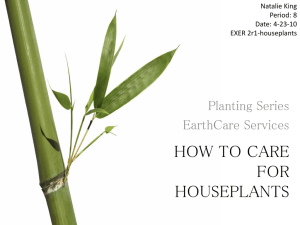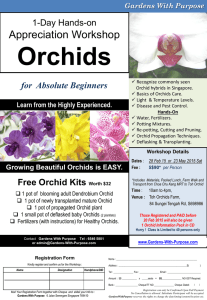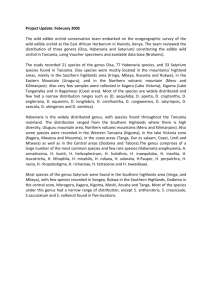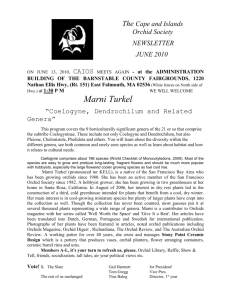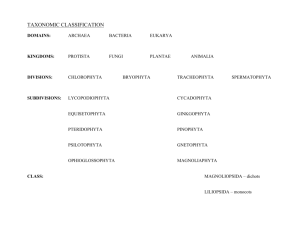Orchid Names: The Basics
advertisement
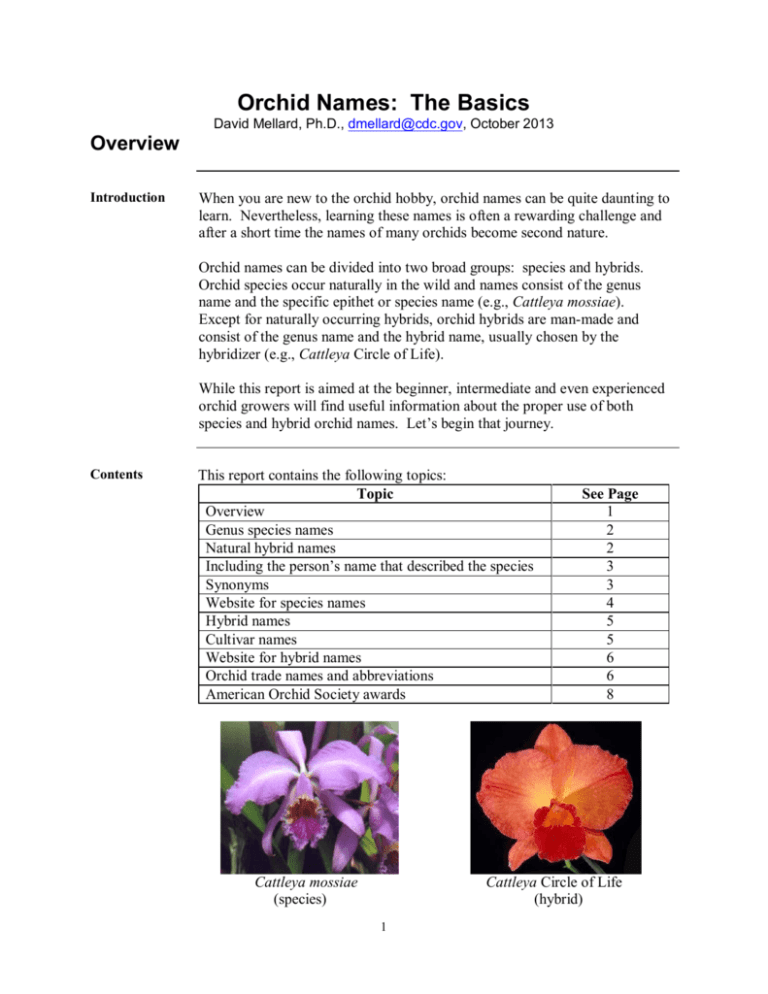
Orchid Names: The Basics David Mellard, Ph.D., dmellard@cdc.gov, October 2013 Overview Introduction When you are new to the orchid hobby, orchid names can be quite daunting to learn. Nevertheless, learning these names is often a rewarding challenge and after a short time the names of many orchids become second nature. Orchid names can be divided into two broad groups: species and hybrids. Orchid species occur naturally in the wild and names consist of the genus name and the specific epithet or species name (e.g., Cattleya mossiae). Except for naturally occurring hybrids, orchid hybrids are man-made and consist of the genus name and the hybrid name, usually chosen by the hybridizer (e.g., Cattleya Circle of Life). While this report is aimed at the beginner, intermediate and even experienced orchid growers will find useful information about the proper use of both species and hybrid orchid names. Let’s begin that journey. Contents This report contains the following topics: Topic Overview Genus species names Natural hybrid names Including the person’s name that described the species Synonyms Website for species names Hybrid names Cultivar names Website for hybrid names Orchid trade names and abbreviations American Orchid Society awards Cattleya mossiae (species) See Page 1 2 2 3 3 4 5 5 6 6 8 Cattleya Circle of Life (hybrid) 1 Orchid Names: The Basics Genus species names Orchid species names follow the traditional binomial nomenclature developed by Carl Linnaeus in the 1700s. The idea is that plants with similar characteristics (and hence similar evolutionary relationships) should be grouped together. Thus, the concept of the genus and species (the binomial) was born to designate a specific group of very similar plants (species) within a larger group with many shared characteristics (genus). The first letter of the genus name is always capitalized and the species name is always lower case, and both names are always in italics. Examples include Cattleya trianae and Paphiopedilum bellatulum. Cattleya trianae Natural hybrid names Paphiopedilum bellatulum Natural hybrids between two species are sometimes found in the wild. Once identified and named, the name of these plants include an ‘x’ between the genus and species names (e.g., Cattleya x hardyana). The ‘x’ is not italicized. The entire name, except the ‘x’, appears in italics. Cattleya x hardyana is a natural hybrid of Cattleya dowiana var. aurea and Cattleya warscewiczii and is found in Colombia. It is important to note that this name is used only for those plants that are wild-collected. Another way to write a hybrid name is Cattleya (dowiana var. aurea x warscewiczii). Dendrobium x superbiens is another natural hybrid of two species (Dendrobium bigibbum x Dendrobium discolor). This natural hybrid is found in Australia, and was described in 1876 by Heinrich Gustav Reichenbach, a German orchidologist. Continued on next page 2 Orchid Names: The Basics, Continued Natural hybrid names (continued) Cattleya x hardyana Including the person’s name that described the species Dendrobium x superbiens In some orchid articles, the person’s name who described the genus or species will also be included as part of the orchid’s name. For example, Phalaenopsis venosa Shim & Fowlie indicates that Phyau Soon Shim and Jack Fowlie described this well-known species. Phalaenopsis venosa Shim & Fowlie Identifying the person or persons that described a species helps to avoid confusion when the same name was used to describe different species. For example, Cattleya crispa Lindl. is the accepted name for this species from southeastern Brazil, while Cattleya crispa Beer is a synonym for Laelia marginata L.O. Williams from northern Brazil. So, what’s a synonym? Synonyms An orchid species can sometimes have more than one name, which happens when botanists describe a species that was described previously. Usually, the accepted name for an orchid is the name that was published first. A good example involves the genera Lycaste, Ida, and Sudamerlycaste. Lycaste was described originally by John Lindley in 1843 and included many species ranging from Mexico to South America. In 2003, Ann Ryan and Henry Oakley reclassified a section of Lycaste predominantly from South America with cream, green, or tan flowers and created the genus Ida. This name was widely accepted and in use for many years. However, Morales Archila, described this section as the genus Sudamerlycaste a few weeks before the Ryan and Oakley publication, thus making Ida a synonym of the genus Sudamerlycaste. Continued on next page 3 Orchid Names: The Basics, Continued Synonyms (continued) Because Ida was accepted in the orchid world, this name is still seen on name tags and at orchid shows; but, according to the World Checklist of Selected Plant Families, the accepted name is now Sudamerlycaste. Synonyms include Lycaste cinnabarina Rolfe and Ida cinnabarina A. Ryan & Oakeley. Sudamerlycaste cinnabarina Websites for species names The World Checklist of Selected Plant Families (formerly the Kew Monocot List) has a searchable database that allows you to find information about the accepted name and synonyms for orchid species and natural hybrids. Additional information includes the date the species or genus was described as well as the persons who named and published the species. http://apps.kew.org/wcsp/prepareChecklist.do?checklist=selected_families%4 0%40100090420121954649. The naming of wild plants is governed by the International Botanical Congress. Their rules for naming wild plants are published as the International Code of Nomenclature for algae, fungi, and plants (ICN) (formerly known as the International Code of Botanical Nomenclature). Numerous changes were made recently in the naming of wild plants at a 2011 conference held in Melbourne, Australia, mostly to accommodate the e-world we now live in. More information about the code is available at http://en.wikipedia.org/wiki/International_Code_for_Botanical_Nomenclature Continued on next page 4 Orchid Names: The Basics, Continued Hybird Names Orchid hybridization has been taking place for over 150 years with the first man-made hybrid being Calanthe Dominyii, which was registered in 1856. This primary hybrid of two species was made by crossing Calanthe triplicata with Calanthe sylvatica and is named after its originator, John Dominy. Note that for hybrids, the genus name is italicized but the hybrid name is not italicized and the first letter of each word is capitalized. Calanthe Dominyi Paphiopedilum Small World A hybrid made up of two species is referred to as a primary hybrid. A hybrid made up two hybrids or a hybrid and a species is referred to as a complex hybrid. For example, Dendrobium Red Emperor is a complex hybrid of two hybrids: Dendrobium Benikujyaku and Dendrobium New Comet. This cross can also be written as Dendrobium Benikujyaku x Dendrobium New Comet or as Dendrobium (Benikujyaku x New Comet). Cultivar Names Cultivar names are given to individual plants (either species or hybrids) that have exceptional qualities. Species and hybrid plants that are awarded by orchid organizations, such as, the American Orchid Society, are usually given a cultivar name. The cultivar name appears after the species or hybrid name and is enclosed in single quotes. Dendrobium Red Emperor has a well-known cultivar, ‘Prince’. Another example is Cymbidium Voodoo ‘Halloween’. Note that no comma appears between the species or hybrid name and the cultivar name. Dendrobium Red Emperor ‘Prince’ Cymbidium Voodoo ‘Halloween’ Continued on next page 5 Orchid Names: The Basics, Continued Website for hybrid names Over 150,000 orchid hybrid names exist. Keeping track of these names is the job of the Royal Horticultural Society (RHS) in the United Kingdom. The RHS maintains a database of hybrid names along with the parents, the hybridizer, the date of registration, and other pertinent information. This searchable database is available at this internet address: http://apps.rhs.org.uk/horticulturaldatabase/orchidregister/orchidregister.asp. The naming of man-made hybrids is governed by the International Code of Nomenclature for Cultivated Plants (ICNCP, Cultivated Plant Code). More information is available at http://en.wikipedia.org/wiki/International_Code_of_Nomenclature_for_Cultiv ated_Plants. Orchid Trade Names With the popularity of orchids increasing along with the ease of massproducing flowering plants, many businesses now carry a nice selection of Cattleya, Phalaenopsis, Paphiopedilum, Dendrobium, and Oncidium. While often these plants are sold without names, occasionally a tag can be found with the orchid trade name. To protect their investment, many companies will use a marketing name to identify the orchid and sell the orchid using their proprietary trade designation. Their trade name is often unique to the company and is not the official registered name of the hybrid. Continued on next page 6 Orchid Names: The Basics, Continued Orchid Trade Names (continued) An example is Phalaenopsis MINI DEER. The proper way to write trade names is to italicize the genus name and to place the trade name in all caps with no quotation marks. The first letter of each word in the trade name should have a slightly larger font than the remaining capital letters. While these plants can be judged for ribbon awards at an AOS-sanctioned show, they cannot be judged for AOS awards because the parents cannot be identified. More information about Trade Names can be found at this website: http://www.internationalplantnam es.com/HTML/English/how_to_us e_the_list.htm Phalaenopsis MINI DEER Orchid Abbreviations The genus name for orchids is often abbreviated. For example, Guarianthe aurantiaca can be abbreviated as Gur. Aurantiaca. Some of the more common abbreviations follow: Phalaenopsis Oncidium Epidendrum Phal. Onc. Epi. Paphiopedilum Vanda Cymbidium Paph. V. Cym. Only genera used in hybridizing have approved abbreviations, which are assigned by the RHS at the time of registration. If no hybrids are registered with a natural genus, the entire name can be spelled out the first time in a document and then abbreviated with the first letter as is done in botanical publications. A complete listing of genera and the appropriate abbreviation is available at http://midamericanorchids.org/judging/ Gur. aurantiaca Onc. Palmyra ‘Golden Girl’, AM/AOS Continued on next page 7 Orchid Names: The Basics, Continued American Orchid Society Awards The American Orchid Society (AOS) grants awards to orchids and exhibitors; and, these awards should be included as part of the plant’s name. For example, a name might be written asAM/AOS, which signifies that this plant was given an award of merit for flower quality by the AOS. Note that a comma appears between the cultivar name and the award designation. If a plant has awards from more than one organization, the awards are listed alphabetically by organization. For example, if a plant has awards from the AOS and the RHS, the AOS award is listed first. Some of the more common AOS awards follow: HCC (Highly Commended Certificate): Awarded to orchid species or hybrids scoring 75 to 79 points inclusive on a 100-point scale. AM (Award of Merit): Awarded to orchid species or hybrids scoring 80 to 89 points inclusive on a 100-point scale. FCC (First Class Certificate): The highest flower-quality award, awarded to orchid species or hybrids scoring 90 points or more on a 100-point scale. JC (Judges' Commendation): Given for distinctive characteristics that the judges unanimously feel should be recognized but cannot be scored in the customary ways. CBR (Certificate of Botanical Recognition): Awarded to rare and unusual species with educational interest that has received no previous awards. The entire plant must be exhibited. This award is granted provisionally and filed with the judging center Chair pending taxonomic verification supplied by the exhibitor. CHM (Certificate of Horticultural Merit): Awarded to a well-grown and wellflowered species or natural hybrid with characteristics that contribute to the horticultural aspects of orchidology, such as aesthetic appeal. This award is granted provisionally and filed with the judging center Chair pending taxonomic verification supplied by the exhibitor. CCM (Certificate of Cultural Merit): Awarded to the exhibitor of a wellflowered specimen plant of robust health. The plant must score between 80 and 89 points inclusive on a 100-point scale. Continued on next page 8 Orchid Names: The Basics, Continued American Orchid Society Awards (continued) CCE (Certificate of Cultural Excellence): Awarded to the exhibitor of a wellflowered specimen plant of robust health. The plant must score more than 90 points on a 100-point scale. Plants receiving this award represent the highest level of orchid culture. PS C. warneri Moore ex Warner Often you will see an orchid name written as Cattleya warneri T.Moore ex R.Warner. This means that T. Moore named the plant and that R. Warner wrote and published the taxonomist description establishing the plant as a new species. PS When not to capitalize genus When do you not capitalize and italicize genus names? Whenever you add an ‘s’ to a genus name the name is not capitalized nor is in italics. The genus name also is not capitalized or in italics when it acts as an adjective. For example, laelias are placed in the cattleya alliance because they are closely related to Cattleya labiata, the type species for cattleyas. A good rule of thumb to use is if you can replace the genus name with the genus and species name, the genus name is italicized and first letter is capitalized. If you can’t, the genus name is not italicized and the first letter is not capitalized. When you learn to not capitalize correctly, you’re sending the message…… I know the rules of nomenclature. 9
